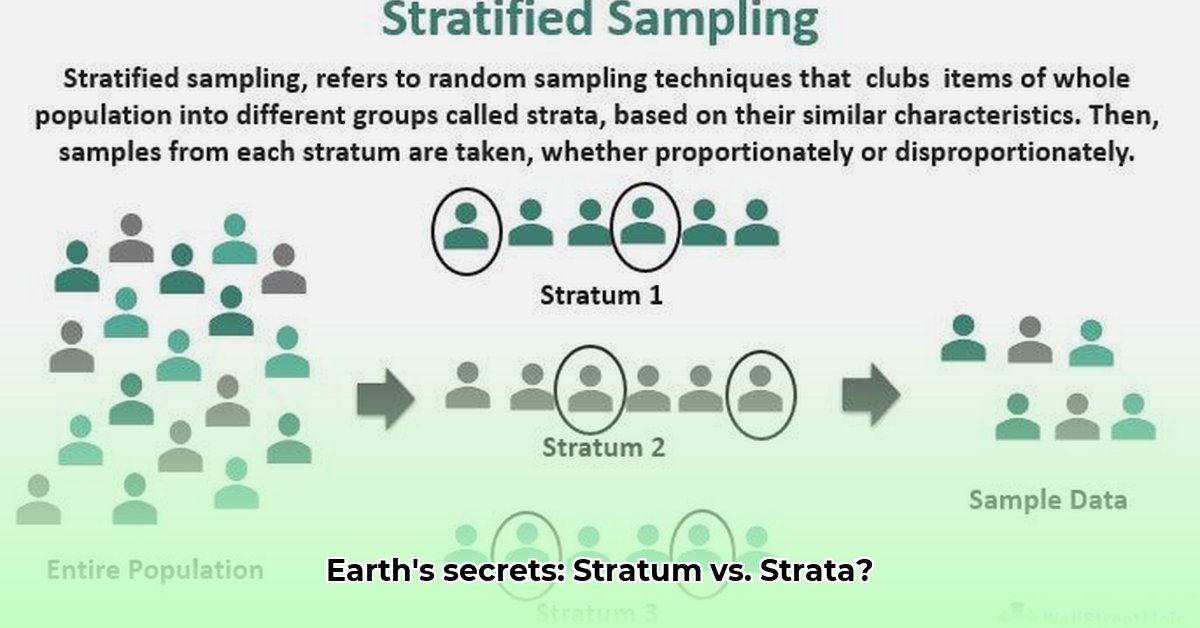
Stratum vs. Strata: Understanding Earth's Layered History
Have you ever gazed at a canyon wall or cliff face and noticed the distinct layers of rock? These layers, fundamental to understanding Earth's history, are known as strata, with each individual layer being a stratum. While seemingly a simple distinction—singular versus plural—grasping this difference is key to interpreting the geological record. This article will explore the nuances between stratum and strata, illustrating how these layers chronicle millions of years of planetary change. We'll delve into how geologists utilize these layers to reconstruct past environments, climate shifts, and even the evolution of life. Did you know that the precise identification of strata is crucial for applications such as mineral exploration and environmental impact assessments?
A stratum (singular) represents a single layer of rock, soil, or sediment. This could range from a thin sheet of sandstone to a thick bed of limestone or a layer of clay. Each stratum preserves unique information about the conditions under which it formed millions of years ago—a snapshot of Earth's past. We can consider each stratum a "page" in the Earth's historical record.
Strata (plural), conversely, refers to multiple layers stacked upon one another. It's the collective term for the entire sequence of layers, much like the whole "book" of Earth's history. Studying strata provides a broader, comprehensive perspective of planetary evolution, revealing the sequence of environmental changes and geological events over vast timescales. Analyzing strata helps us trace continental movement, understand climate fluctuations, and reconstruct ancient ecosystems.
The scientific approaches to analyzing a stratum and strata differ considerably. Analyzing a single stratum often involves detailed microscopic examination of the rock's composition, radiometric dating to determine its age, and the identification of any embedded fossils. It's like thoroughly researching a single photograph to understand a specific moment in time. This detailed analysis gives specific information about a particular point in space and time.
Conversely, studying strata involves broader techniques like geological mapping, which traces the layers across expansive areas. Geologists compare these layers in different locations to build a comprehensive chronological narrative of Earth's history. This involves understanding large-scale events like ice ages, volcanic eruptions, and tectonic plate movements—getting the big picture of Earth's long-term transformations.
Why is this distinction important? The precise use of stratum and strata is not mere pedantry; it's fundamental to clear scientific communication and accurate geological interpretation. Accurate terminology underpins the models used in critical applications such as resource exploration and environmental impact assessments. Ambiguity in this area can lead to serious errors with potentially significant consequences.
Real-world applications of this knowledge are multifaceted. For example, understanding the orientation and characteristics of strata is critical to petroleum exploration, influencing decisions on drilling locations and the estimation of reservoir size. Similarly, the analysis of strata provides essential information concerning the stability of slopes and the influence of geological structures on construction and infrastructure projects.
However, the analysis isn't always simple. Geological layers are not always neatly organized. Tectonic forces can distort layers, creating complex structures and making the identification of individual strata difficult. This requires advanced techniques and careful analysis. Scientists continually research and develop better methods to decipher these intricate formations.
Key Takeaways:
- The distinction between stratum (singular) and strata (plural) is critical for precise geological interpretation.
- Each geological stratum represents a distinct layer with a unique story of past Earth conditions.
- Analyzing both individual strata and the broader context of strata sequences is crucial for a complete understanding of Earth's history.
- Advanced techniques are often necessary to differentiate between subtle variations in complex geological formations.
How to Differentiate Between Subtle Geological Strata in Complex Formations
The seemingly simple task of identifying individual strata can become incredibly complex in intricate geological formations. How do geologists unravel these layered puzzles? Let's explore the techniques and challenges involved.
Visual Clues: Uncovering Subtle Differences
Even when layers appear similar, subtle differences provide crucial clues. These include:
- Color variations: Subtle shifts in color reflect changes in mineral composition or the presence of different sediments.
- Texture variations: The grain size (coarse or fine) and sorting (well-sorted or poorly sorted) reveal aspects of the depositional environment.
- Compositional contrasts: Identifying the minerals present helps pinpoint the source of the sediments and their depositional conditions.
- Fossil content: The presence, absence, and type of fossils provide valuable insights into past life and environments.
Advanced Analytical Techniques
Visual clues alone aren't always sufficient. Advanced techniques provide a more precise understanding:
- Thin-section analysis: Examining microscopic slices of rock reveals minute details invisible to the naked eye.
- Geochemical testing: Analyzing chemical composition reveals trace elements and isotopes that further differentiate strata.
Meticulous Documentation: The Foundation of Accurate Interpretation
Detailed field notes—including location, stratum descriptions, measurements, sketches, and photographs—are essential. A detailed stratigraphic log is crucial for accurately documenting and interpreting the observed strata.
By combining visual observations, advanced techniques, and meticulous recording, geologists piece together the complex history recorded within Earth's layered formations. This understanding is not just academic, it is crucial for many practical applications in various fields from resource management to hazard assessment and risk mitigation.